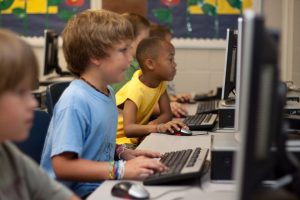
https://pixabay.com/photos/students-computer-young-boy-99506/
For a couple years now, I have done a science research activity that uses digital literacy skills to teach students how to collect information from reliable sources. The students have to do research on various infectious diseases and then make up their own disease. They have to think about the other infectious diseases and determine what made them so dangerous and then create their own disease based on what they think would make it the deadliest. They have to justify why it is so deadly and explain how the pathogen is transmitted, what the symptoms are and how it can be cured. It requires them to do research on the library database, to find reliable websites for information and then to create a 3D model of their pathogen using a computer program called Tinkercad. Prior to the actual research, we have discussions about where to find reliable sources and what types of websites are appropriate for educational research. This assignment mainly develops information literacy skills as described by Weiss (2017), as the students are responsible for “evaluating the quality and validity of information” that they find in their research. They present this information in their choice of a powerpoint, poster or information table with pictures.
This year, I would like to modify the activity so that it also includes the development of reproduction literacy skills by asking them to create a blog. This will allow them to create meaningful, authentic, and creative work, by integrating existing independent pieces of information (Weiss, 2017). The students will be required to create and share their research in a blog and will learn how to add hyperlinks and pictures to aid in the readers understanding and to interact with the content the students provide them. Prior to the start of their research, I would also like to add in the Mozilla’s (n.d.) ‘Web Detective’ activity where they will “collaborate to create a set of rules to guide them in evaluating web sources” and give them a greater participatory experience when learning this digital literacy skill. In this way, they will learn to read, write and participate online to improve their web literacy and 21st century skills (Mozilla). They will use these skills to then explore the ‘fake news’ surrounding the coronavirus and present their findings in a blog post.
References
Mozilla. (n.d.). Web literacy. Retrieved from https://learning.mozilla.org/en-US/web-literacy
Weiss, D. (2017, December 2). The essential elements of digital literacy for the 21st century workforce [Web log post]. Retrieved from https://enabley.io/the-essential-elements-of-digital-literacy-for-the-21st-century-workforce-infographic/

Leave a Reply